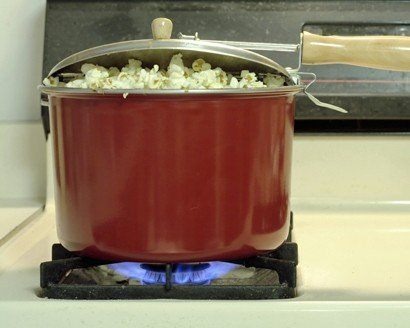5 Reasons To Make Popcorn On The Stove
It's hard to argue against the convenience of microwave popcorn in a bag, but making popcorn on the stove the old-fashioned way — starting with kernels and oil in a pot with a lid — carries a certain air of nostalgia with it, and it certainly has its merits.
Value. Microwave popcorn bags are pricey — about $1 per 3-ounce bag on average. A bag of regular popcorn kernels will run you about $3 for 32 ounces — just a couple of dollars more for more than 10 times the amount. And a little goes a long way, because just ¼ cup of popcorn kernels yields about 8 cups of popped kernels.
Keep Them Popping. Beep, beep, beep — click. Yes! It's done at last! Quick, quick, open the bag. A rush of steam escapes, a shake of the bag, and it's time to enjoy some hot, perfectly popped, buttery, crunchy popcorn. But as you near the bottom, the inevitable disappointment sets in. Shoot! "Why do I keep buying these stupid bags," you say to yourself, "when this happens every time?" Sure enough, a layer of un-popped kernels lines the bottom of the bag. And it's not like you can put the bag back in.
Maybe the next bag will be better with a little more time in the microwave. But this is folly, because there's always the risk of having a whole bag of overcooked popcorn. Better to leave some kernels at the bottom. Or make popcorn on the stove.
Real Butter. What is "movie theater butter" anyway? Look closely at the package and you'll probably see palm oil and natural flavors listed on the ingredient list, but as for butter? Sometimes, it's nowhere to be found. Even if there is butter, it's generally cut with palm oil. Don't get taken for a ride — make your own popcorn at home and watch the butter melt before your eyes.
Creativity. The sky's pretty much the limit when it comes to topping popcorn these days. Want to whip up some Sriracha butter and toss it with Parmesan? There's a popcorn recipe for that. How about Kahlúa and espresso bean caramel corn? There's a recipe for that, too. But even if you don't want to follow a recipe, if you plan on drizzling on your own toppings, it's best to start with kernels from a jar instead of a microwavable bag. That's because microwave popcorn from a bag often contains additives that will impart off-tasting flavors.
Click here to see 12 Ways to Spice Up Popcorn
Health. Microwavable popcorn bags are sometimes coated with perfluorinated compounds (PFCs) to keep them from absorbing too much grease and breaking down, according to Rick Smith and Bruce Lourie, authors of Slow Death by Rubber Duck. PFCs also coat fast-food wrappers and pizza boxes for the same purpose. However, this class of slippery compounds is most famously used to make the coating on nonstick pans and give fabrics water- and stain-repellent properties, marketed under the names Teflon, Gore-Tex, and Stainmaster. This probably isn't stuff that you would want touching your food. Perfluorooctonoic acid, the PFC behind Teflon, for instance, has been classified by the Environmental Protection Agency as a likely carcinogen, and nothing breaks it down — not even stomach acid. Talk about indigestion.
Will Budiaman is the Recipe Editor at The Daily Meal. Follow him on Twitter @WillBudiaman.
